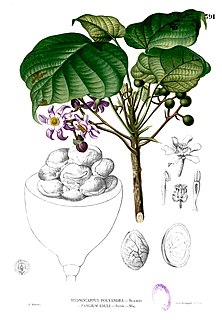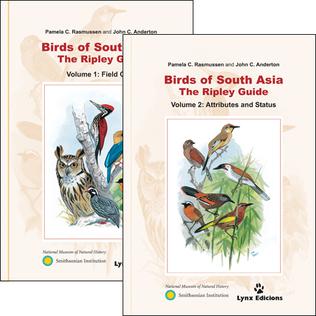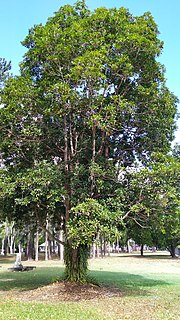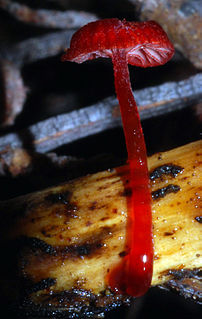
Cryptocoryne is a genus of aquatic plants from the family Araceae. The genus is naturally distributed in tropical regions of India, Southeast Asia and New Guinea.

Elaeocarpus is a genus of nearly five hundred species of flowering plants in the family Elaeocarpaceae native to the Western Indian Ocean, Tropical and Subtropical Asia and the Pacific. Plants in the genus Elaeocarpus are trees or shrubs with simple leaves, flowers with four or five usually petals and usually blue fruit.

Achariaceae is a family of flowering plants consisting of 32-33 genera with about 155 species of tropical herbs, shrubs, and trees. The APG IV system has greatly expanded the scope of the family by including many genera previously classified in Flacourtiaceae. Molecular data strongly support the inclusion of this family in the order Malpighiales.

Ipsea is a genus of the Orchid family (Orchidaceae), with three species that are found in India, Sri Lanka and Thailand.

The brown palm civet also called the Jerdon's palm civet is a palm civet endemic to the Western Ghats of India.
Elaeocarpus glandulifer is a species of flowering plant in the Elaeocarpaceae family. It is endemic to Sri Lanka, mainly in South-western areas.

Elaeocarpus munroi is a species of flowering plant in the Elaeocarpaceae family and is endemic to India. It was first formally described in 1838 by Robert Wight who gave it the name Monocera munroii in his book Illustrations of Indian Botany. In 1874, Maxwell T. Masters changed the name to Elaeocarpus munroi in the Hooker's Flora of British India. The specific epithet (munroi) honours the botanist, William Munro.

Birds of South Asia: The Ripley Guide by Pamela C. Rasmussen and John C. Anderton is a two-volume ornithological handbook, covering the birds of South Asia, published in 2005 by the Smithsonian Institution and Lynx Edicions. The geographical scope of the book covers India, Bangladesh, Pakistan, Sri Lanka, Nepal, Bhutan, Maldives, the Chagos archipelago and Afghanistan. In total, 1508 species are covered. Two notable aspects of Birds of South Asia are its distribution evidence-base — the book's authors based their distributional information almost completely on museum specimens — and its taxonomic approach, involving a large number of species-level splits.

Elaeocarpus bancroftii, commonly known Kuranda quandong, Johnstone River almond, ebony heart, grey nut, or nut tree is a species of flowering plant in the family Elaeocarpaceae and is endemic to Queensland. It is a tree with leathery leaves that turn red before falling, flowers with lobed petals and relatively large fruit.

Mycena minirubra is a species of fungus in the family Mycenaceae. Found only in New Zealand, the fungus produces tiny crimson fruit bodies with caps up to 1 mm (0.04 in) in diameter, atop that stems that arise from a basal disk of mycelium.

Elaeocarpus serratus is a tropical flowering plant in the family Elaeocarpaceae. It is found in the Indian Subcontinent, Indo-China and South East Asia. It is an ornamental medium-sized tree indigenous to Sri Lanka, that produces smooth, ovoid green fruits that have nutritive and medicinal value. This Ceylon olive is a beneficial herbal plant used to treat various diseases.

Elaeocarpus lanceifolius is a tree species in the family Elaeocarpaceae. It is found across tropical Asia from Thailand to Yunnan to Nepal to Karnataka, India. It is used for its wood, fruit, and nuts.
Endostemon is a genus of plants in the family Lamiaceae, first described in 1910. It is native primarily to eastern Africa, with some species in central and southern Africa, the Arabian Peninsula, Madagascar, and the Indian subcontinent.
- Endostemon albusA.J.Paton, Harley & M.M.Harley - Kenya, Tanzania, Mozambique
- Endostemon camporum(Gürke) M.R.Ashby - Kenya, Tanzania
- Endostemon ctenoneurusHarley - Kenya, Somalia
- Endostemon glandulosusHarley & Sebsebe - Ethiopia
- Endostemon gracilis(Benth.) M.R.Ashby - Kenya, Somalia, Tanzania, Yemen
- Endostemon kelleri(Briq.) Ryding ex A.J.Paton & Harley - Kenya, Somalia, Ethiopia
- Endostemon leucosphaerus(Briq.) A.J.Paton, Harley & M.M.Harley - Somalia, Ethiopia
- Endostemon membranaceus(Benth.) Ayob. ex A.J.Paton & Harley - Cameroon, Angola, Central African Republic
- Endostemon obbiadensis(Chiov.) M.R.Ashby - Somalia
- Endostemon obtusifolius(E.Mey.) N.E.Br. - from South Africa north to Angola and Tanzania
- Endostemon racemosusRyding, A.J.Paton & Thulin - Somalia
- Endostemon stenocaulis(Hedge) Ryding, A.J.Paton & Thulin - Somalia
- Endostemon tenuiflorus(Benth.) M.R.Ashby - eastern + southern Africa, Madagascar, Arabian Peninsula
- Endostemon tereticaulis(Poir.) M.R.Ashby - widespread across much of tropical Africa, also Yemen + Saudi Arabia
- Endostemon tomentosusHarley & Sebsebe - Somalia
- Endostemon tubulascens(Briq.) M.R.Ashby - Angola
- Endostemon usambarensisM.R.Ashby - Tanzania
- Endostemon villosus(Briq.) M.R.Ashby - central Africa
- Endostemon viscosus(Roth) M.R.Ashby - India, Assam, Sri Lanka
- Endostemon wakefieldii(Baker) M.R.Ashby - Kenya

Rubus fruticosus L. is the ambiguous name of a European blackberry species in the genus Rubus in the rose family. The name has been interpreted in several ways:

Elaeocarpus amoenus is a species of flowering plant in the Elaeocarpaceae family used as a medicinal plant. It is endemic to Sri Lanka, where it is called "Thiththa weralu – තිත්ත වෙරළු" by local people.
Elaeocarpus montanus is a species of flowering plant in the Elaeocarpaceae family used as a medicinal plant. It is endemic to Sri Lanka. It is known as "Gal weralu - ගල් වෙරලු" by Sinhalese people.
Elaeocarpus taprobanicus is a species of flowering plant in the Elaeocarpaceae family used as a medicinal plant. It is one of three recently described species that is endemic to Sri Lanka.
Elaeocarpus thorelii is a tree in the family Elaeocarpaceae, endemic to Cambodia, and used for its wood.
Elaeocarpus stipularis is a tree in the Elaeocarpaceae family. It is found from the Aru Islands, eastern Indonesia, to Philippines, and through Mainland Southeast Asia to Odisha, India. It has edible fruit, its wood is used and some medical uses are ascribed to it.












